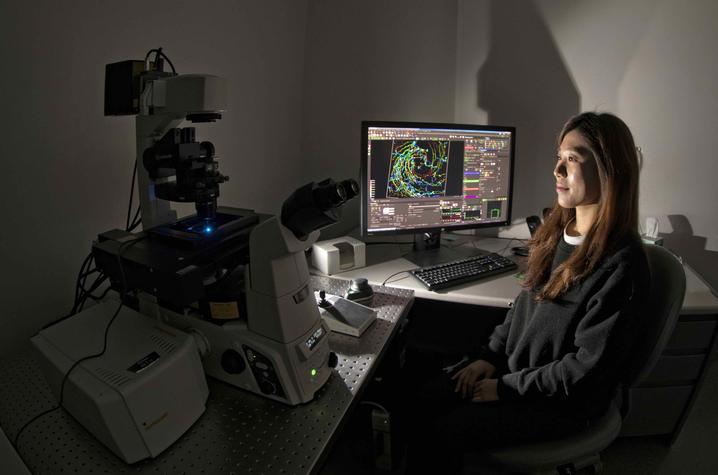Quality Research Space is Crucial to What We Do

Monday, April 24, 2017
Two years ago, President Capilouto articulated a vivid and focused vision for the University of Kentucky—for how our campus can impact the Commonwealth and the broader world we serve. At the groundbreaking for the UK’s $265 million multidisciplinary research facility, he said that it was time for us, together, “to make death a beggar in Kentucky.”
It’s the idea that through world-class research across an array of disciplines, and a commitment to working as partners with communities across the state, some of the most stubborn health challenges and statistics that plague Kentucky can be successfully attacked.
We hear and see these unrelenting statistics time and again; and yet they remain just as stark, just as anguishing. Among other issues, we lead the nation in cancer deaths, and we have the fifth-highest obesity rate in the country. Hundreds of Kentuckians die each year due to cancer, heart and pulmonary disease, stroke and other preventable illnesses.
Where does the University fit in this challenge?
This is the type of research that we – as the University for Kentucky – are uniquely positioned to conduct. It’s all here at UK – a leading medical center with a referral network throughout the region and leading national centers in cancer, in aging, and in the capacity to move discoveries from the lab and into communities. And we have already made significant gains in these areas.
Two important factors make life-altering and transformative research possible – talent and infrastructure.
Just last week, we announced a $11.2 million cancer research grant from the Centers of Biomedical Research Excellence (COBRE). Provided by the National Institutes of Health, the COBRE grant builds capacity for our internationally renowned experts in cancer and metabolic research to advance our understanding and treatment of cancer. While scientists have long known of a direct link between obesity and cancer, the need for further research into this field is a necessity for Kentuckians – that’s what the COBRE grant is designed to do.
This is just one example, among many, of the important work occurring across our campus—work that leads to real, positive impact on the lives of our fellow Kentuckians. To continue these important efforts, we must equip our researchers with the space, facilities and tools to conduct their work.
We have tremendous talent in research today, but the problems that face our state require even more. Two years ago, we were nearly out of space – the infrastructure – necessary to do this work. Today, we are building that capacity, but will need even more in the years ahead to do the work for the Commonwealth that only we can do at UK. The two are interconnected.
In particular, high-tech, high-touch research space is what enables an institution like UK to recruit and retain talent. What are we doing to create the kind of space to ensure we have that talent?
We partnered in 2015 with the Kentucky General Assembly to fund construction of the new research building, because a significant amount—the majority—of our existing research space is currently occupied. For example, in fiscal year 2016, 85 percent of wet-lab research space was occupied. This high occupancy rate leaves little available space to recruit new investigators to the institution who can join our teams searching for answers to pressing questions.
Moreover, we conducted a space quality assessment the same year to determine the capabilities of our current facilities. This revealed that much of our current space across campus is outdated and not suitable for modern research laboratories (e.g., insufficient design to remove fumes, have appropriate airflow, perform certain types of research).
Most of our modern research space is occupied. Make no mistake—recruiting strong talent is absolutely crucial to what we do. We want the strongest and most qualified individuals tackling Kentucky challenges and serving Kentucky communities. Take, for example, Dr. Mark Evers, the director of the Markey Cancer Center. Under his leadership, Markey earned the prestigious NCI-designation from the National Institutes of Health.
That watershed moment was made possible by years of hard work by leaders and pioneering researchers committed to a singular goal: fighting the scourge of cancer that too often scars Kentucky families. Now, we are serving more families with an even higher quality of care, and we are generating more discovery in this area than at any time in our history.
It happens through recruiting the best possible people—the best possible teams—and by fostering a collaborative environment. This is exactly what the new research building is designed to do.
The design of the new facility promotes collaboration within the wet laboratory space. The labs are arranged in a neighborhood design, with six laboratory benches that are occupied by multiple investigators. This promotes synergy between investigators, and also brings investigators from different disciplines into close proximity.
The laboratories are flanked by procedure rooms that maximize research efficiency. In other words, the space is optimized to modern research approaches, and to foster collaboration and team-science.
There is an additional connector building between the new research facility and existing research buildings (BBSRB, Biopharm). This connector will house researchers who approach the problem from different viewpoints, meaning they may study economics, behavior, clinical, computational and other aspects that contribute to chronic diseases like cancer, obesity/diabetes, cardiovascular diseases and substance abuse.
This is what we must do to address these difficult problems: collaboration—across various disciplines—to achieve a common goal. We will continue to recruit the best individuals to tackle these problems. New research space will strengthen our ability turn questions into solutions —innovative research that “makes death a beggar in Kentucky.”
Eric N. Monday
@UKYMonday
#seeblue




